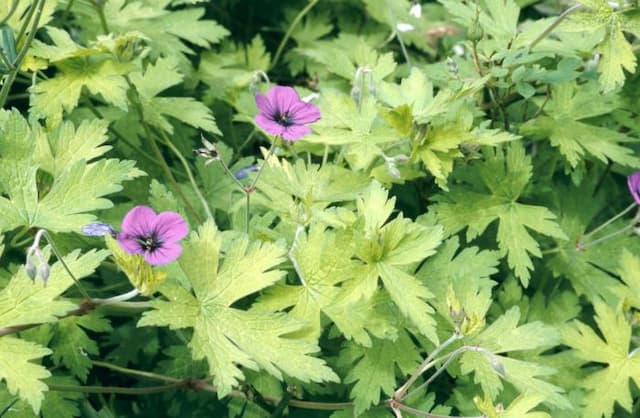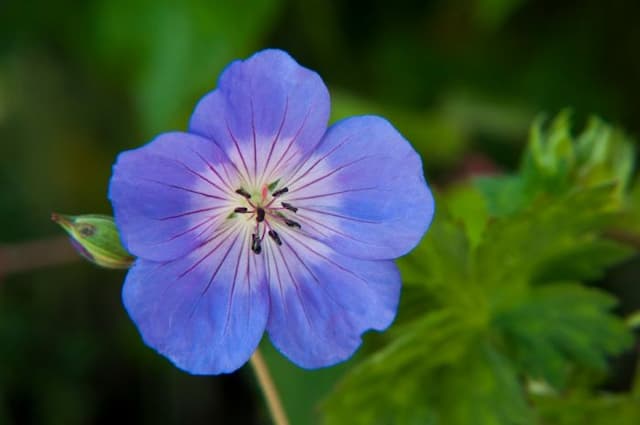Geranium Geranium malviflorum

ABOUT
Geranium malviflorum, also known as Mallow-leaved Crane's-bill, is a flowering plant characterized by its distinctive foliage and blossoms. The leaves of this plant are typically rounded, with a heart or kidney-shaped base, and they possess a softly lobed structure that gives them a somewhat jagged appearance. The surface of the leaves may have a gentle velvety texture with fine hairs that add a subtle sheen. The flowers of Mallow-leaved Crane's-bill present a striking contrast against the greenery with their bright and vivid coloration that spans shades of purple, pink, or blue, often with noticeable veining that radiates from the center. Each flower typically has five petals that are rounded and slightly overlapping, creating a cupped or bowl-like shape that is delicate yet eye-catching. At the center, the floral structures such as stamens create an intricate focal point that draws the eye. Supporting these flowers and leaves are stems that are both sturdy and slender, with a tendency to branch and spread gracefully, giving the plant an open and airy feel. The stems may contain fine hairs similar to those on the leaves, contributing to a cohesive appearance that is pleasing to the eye. The plant exudes a charming and rustic beauty, making it a popular choice for gardeners and enthusiasts who appreciate its simple yet enchanting aesthetic.
About this plant
 Names
NamesSynonyms
Mallow-Leaved Stork's Bill
Common names
Geranium malviflorum.
 Toxicity
ToxicityTo humans
Geranium malviflorum, more commonly known as geranium, is generally considered non-toxic to humans. However, some people may experience mild irritation or an allergic reaction if they have sensitive skin or existing allergies upon handling the plant. Ingesting parts of this plant is not recommended as it may cause gastrointestinal discomfort including nausea, vomiting, or diarrhea in some individuals.
To pets
Geranium malviflorum, commonly known as geranium, is considered to be toxic to pets, especially cats and dogs. The toxic components are geraniol and linalool, which are found in the essential oils of the plant. Symptoms of geranium poisoning in pets can include vomiting, diarrhea, lethargy, depression, anorexia, and dermatitis if there is skin contact. In more severe cases, pets may experience hypothermia, ataxia, and in rare cases, it can lead to death if not treated promptly. If you suspect your pet has ingested geranium, it is important to seek veterinary care immediately.
 Characteristics
CharacteristicsLife cycle
Perennials
Foliage type
Deciduous
Color of leaves
Green
Flower color
Pink
Height
1-2 feet (30-60 cm)
Spread
1-2 feet (30-60 cm)
Plant type
Herb
Hardiness zones
Varies
Native area
Mediterranean
Benefits
 General Benefits
General Benefits- Aesthetic Appeal: Geranium malviflorum, commonly known as Mallow-leaved Geranium, adds beauty to gardens with its vibrant flowers and attractive foliage.
- Easy to Grow: It is known for being low-maintenance and easy to grow, making it an excellent choice for beginner gardeners.
- Drought Tolerance: This plant exhibits a good level of drought resistance, which makes it suitable for xeriscaping and water-wise gardens.
- Pest Resistance: Mallow-leaved Geranium is generally resistant to many common garden pests, reducing the need for chemical treatments.
- Pollinator Friendly: The flowers of the Geranium malviflorum attract pollinators like bees and butterflies, supporting local ecosystems.
- Adaptability: It can thrive in a variety of soil types as long as there is good drainage.
- Seasonal Interest: The plant provides seasonal interest with blooms that often appear in the warmer months.
- Container Gardening: It is suitable for container gardening, which allows for versatility in placing the plant in various locations.
- Ground Cover: This Geranium can serve as an effective ground cover, filling in spaces and suppressing weeds.
 Medical Properties
Medical Properties- Anti-inflammatory: Geranium malviflorum has been traditionally used to reduce inflammation.
- Antimicrobial: The plant may possess properties that help to inhibit the growth of certain bacteria and fungi.
- Astringent: It is sometimes used for its astringent properties, which can help to tighten tissues and reduce secretions.
- Wound healing: Compounds in the plant are believed to facilitate the healing process of cuts and wounds.
- Antioxidant: Geranium malviflorum may contain antioxidants that protect cells from oxidative stress.
 Air-purifying Qualities
Air-purifying QualitiesThis plant is not specifically known for air purifying qualities.
 Other Uses
Other Uses- Geraniums can be used as a natural dye, imparting a range of colors from pink to brown depending on the mordant used.
- They may serve as a companion plant in the garden, helping to repel certain insect pests due to their citronella-like scent.
- The leaves of geraniums can be infused in water to create a fragrant rinse for linens or hair.
- Geranium plant material, including leaves and flowers, can be utilized in potpourri mixtures for their long-lasting scent.
- Flowers can be crystallized with egg whites and sugar and used to decorate cakes or desserts.
- Floral elements of geraniums can be used in the creation of perfumes and essential oils for their aromatic properties.
- Leaves can be used to line sugar jars or tea tins to impart a subtle fragrance and flavor.
- Essential oil from geraniums can be mixed with water to create a natural insect-repelling spray.
- Used in art, geranium petals and leaves can be pressed and included in paper making for decorative purposes.
- When dried, both leaves and blooms of the geranium can serve as a natural air freshener when placed in sachets.
Interesting Facts
 Feng Shui
Feng ShuiThe Geranium is not used in Feng Shui practice.
 Zodiac Sign Compitability
Zodiac Sign CompitabilityThe Geranium is not used in astrology practice.
 Plant Symbolism
Plant Symbolism- Health: Geraniums are often associated with health and vitality, representing the body's ability to heal and maintain well-being.
- Friendship: The geranium is sometimes given as a gift to represent friendship and positive relations, as it is a hardy plant that can symbolize the durability of a solid friendship.
- Love: Certain colors of geraniums, like pink, can symbolize love and preference, making it a subtle way to show affection towards someone.
- Protection: Geraniums are thought to ward off negative energies and are typically used in gardens or homes for protection.
- Fertility: In some traditions, geraniums represent fertility and the creation of new life, akin to the plant’s propensity for growth and proliferation.
 Water
WaterFor Geranium malviflorum, commonly known as the common geranium, watering should be moderate and consistent. Provide enough water to moisten the soil but avoid waterlogging as this can lead to root rot. Typically, watering once a week with approximately 16-24 ounces of water should suffice, but this can vary depending on climate and indoor conditions. During the growing season in spring and summer, water when the topsoil feels dry to the touch. In winter, reduce watering to every other week or when the soil is dry several inches deep.
 Light
LightCommon geraniums thrive in bright, indirect sunlight. They perform best in spots that receive several hours of morning sunlight but are shielded from the intense afternoon sun. A location near an east-facing window would provide optimal light conditions without exposing the plant to the harsh midday sun which can scorch the leaves.
 Temperature
TemperatureCommon geraniums prefer temperate conditions and can survive in temperatures ranging from about 55 to 75 degrees Fahrenheit. They should be protected from frost, which means temperatures should not drop below 40 degrees Fahrenheit. Ideally, maintaining an environment around 65 to 70 degrees Fahrenheit will promote healthy growth and flowering.
 Pruning
PruningPruning common geraniums is important to encourage bushier growth and more blooms. Remove dead or yellowing leaves and spent flower heads to direct energy back into the plant. Pruning is best done in the spring or after the plant has finished a major bloom cycle. Regularly deadheading, or removing the faded flowers, will also increase the frequency and vibrancy of new blooms.
 Cleaning
CleaningAs needed
 Soil
SoilThe best soil mix for a Geranium, commonly called cranesbill, is well-draining and fertile with a mixture of two parts garden soil, one part peat moss or coconut coir, and one part perlite or sand. Cranesbills prefer a slightly acidic to neutral soil pH, ranging from 5.8 to 7.0.
 Repotting
RepottingCranesbills, like Geranium malviflorum, should typically be repotted every 1-2 years to refresh the soil and provide room for growth. If the plant is overgrowing its container or if the soil is degraded, it's time to repot.
 Humidity & Misting
Humidity & MistingCranesbills thrive in moderate humidity conditions but are adaptable to various humidity levels in home environments. Therefore, average room humidity is generally suitable, with levels around 40-60%.
 Suitable locations
Suitable locationsIndoor
Provide bright, indirect light, and well-draining soil for indoor cranesbills.
Outdoor
Place cranesbills in light shade to full sun with moist, fertile soil.
Hardiness zone
4-8 USDA
 Life cycle
Life cycleGeranium malviflorum, commonly known as "Mallow-leaved Geranium," begins its life cycle as a seed, which under favorable conditions of moisture and temperature, germinates in the soil. The seedling grows to develop a deep taproot and a rosette of leaves in its early vegetative stage. As the plant matures, it develops long, branching stems bearing green, palmate leaves with deep lobes, and the plant starts to produce distinctive pink to purple flowers with veined petals that attract pollinators. Following pollination, typically by bees or other insects, the flowers develop into beak-like fruit capsules, commonly referred to as "cranesbills", which contain the seeds. Once mature, these seed capsules disperse their seeds, either by ballistic dispersal or through the movement of animals, allowing the plant to spread and start new geraniums at some distance from the parent. The plant may die back during cold, unfavorable seasons, only to regrow from the roots when conditions improve, completing its perennial life cycle.
 Propogation
PropogationPropogation time
Spring-Summer
The most popular method of propagating Geranium malviflorum, commonly known as geranium, is through stem cuttings. Typically, the best time to take cuttings is in late spring or early summer when the plant's growth is most vigorous. To propagate, one must select healthy, non-flowering stems and cut a 4 to 6 inch (about 10 to 15 cm) length, making sure there are at least three nodes present. The lower leaves are removed and the cut end may be dipped in rooting hormone powder to encourage root development. The cutting is then planted in a moist potting mix, with the bottom two nodes buried in the soil. It should be kept in indirect light and maintained at a consistent moisture level until roots have developed, which usually takes a few weeks. After roots have formed, it can be transplanted to a more permanent location.









